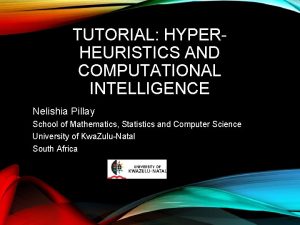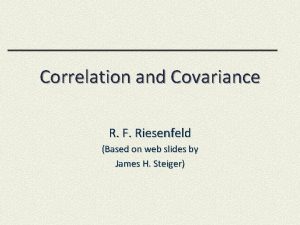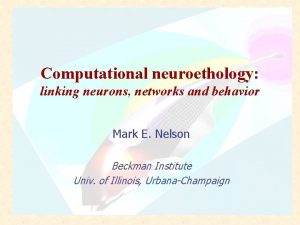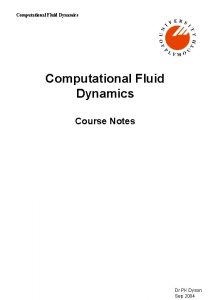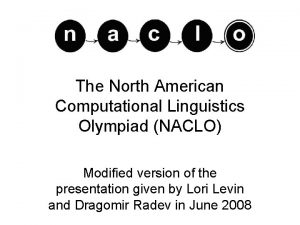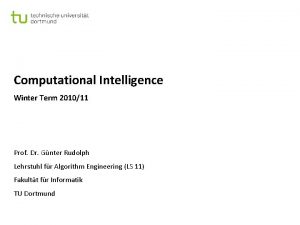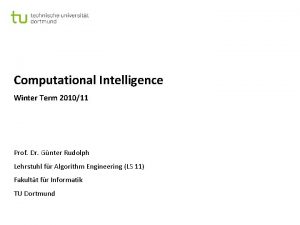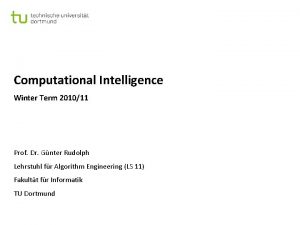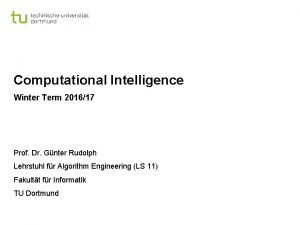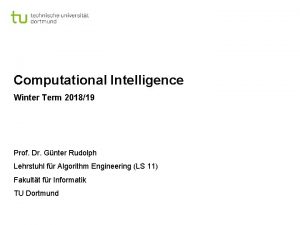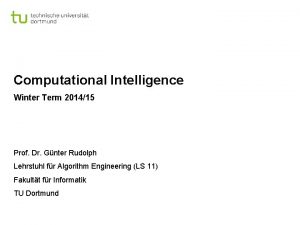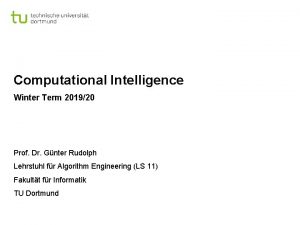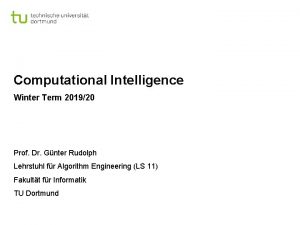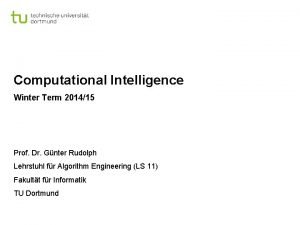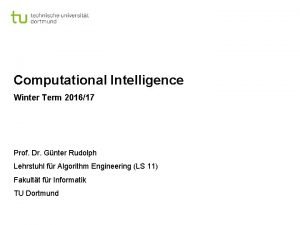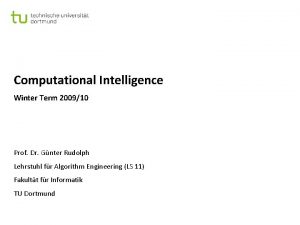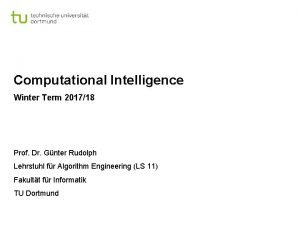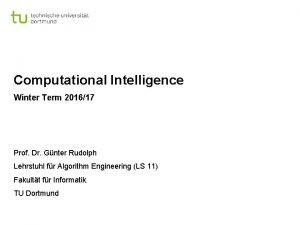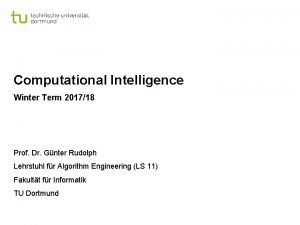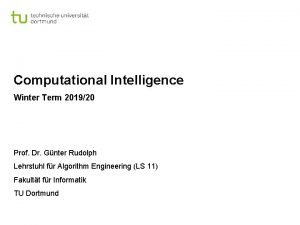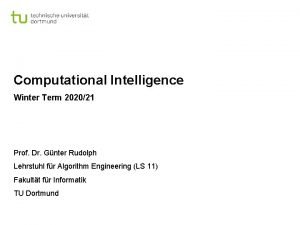Computational Intelligence Winter Term 201011 Prof Dr Gnter





























- Slides: 29

Computational Intelligence Winter Term 2010/11 Prof. Dr. Günter Rudolph Lehrstuhl für Algorithm Engineering (LS 11) Fakultät für Informatik TU Dortmund

Plan for Today Lecture 02 ● Single-Layer Perceptron § Accelerated Learning § Online- vs. Batch-Learning ● Multi-Layer-Perceptron § Model § Backpropagation G. Rudolph: Computational Intelligence ▪ Winter Term 2010/11 2

Lecture 02 Single-Layer Perceptron (SLP) Acceleration of Perceptron Learning Assumption: x 2 { 0, 1 }n ) ||x|| ≥ 1 for all x ≠ (0, . . . , 0)‘ If classification incorrect, then w‘x < 0. Consequently, size of error is just = -w‘x > 0. ) wt+1 = wt + ( + ) x w‘t+1 x for > 0 (small) corrects error in a single step, since = (wt + ( + ) x)‘ x = w‘t x + ( + ) x‘x = - + ||x||2 = (||x||2 – 1) + ||x||2 > 0 ≥ 0 >0 G. Rudolph: Computational Intelligence ▪ Winter Term 2010/11 3

Lecture 02 Single-Layer Perceptron (SLP) Generalization: Assumption: x 2 Rn ) ||x|| > 0 for all x ≠ (0, . . . , 0)‘ as before: wt+1 = wt + ( + ) x ) for > 0 (small) and = - w‘t x > 0 w‘t+1 x = (||x||2 – 1) + ||x||2 < 0 possible! > 0 Idea: Scaling of data does not alter classification task! Let Set = min { || x || : x 2 B } > 0 ^x = x ) set of scaled examples B ) || x ^|| ≥ 1 ^ ) || x ||^2 – 1 ≥ 0 ) w’t+1 x > ^0 G. Rudolph: Computational Intelligence ▪ Winter Term 2010/11 4

Lecture 02 Single-Layer Perceptron (SLP) There exist numerous variants of Perceptron Learning Methods. Theorem: (Duda & Hart 1973) If rule for correcting weights is wt+1 = wt + t x (if w‘t x < 0) 1. 8 t ≥ 0 : t ≥ 0 2. 3. then wt → w* for t → 1 with 8 x‘w* > 0. e. g. : t = > 0 or ■ t = / (t+1) for > 0 G. Rudolph: Computational Intelligence ▪ Winter Term 2010/11 5

Lecture 02 Single-Layer Perceptron (SLP) as yet: Online Learning → Update of weights after each training pattern (if necessary) now: Batch Learning → Update of weights only after test of all training patterns → Update rule: wt+1 = wt + x ( > 0) w‘t x < 0 x 2 B vague assessment in literature: • advantage : „usually faster“ • disadvantage : „needs more memory“ just a single vector! G. Rudolph: Computational Intelligence ▪ Winter Term 2010/11 6

Lecture 02 Single-Layer Perceptron (SLP) find weights by means of optimization Let F(w) = { x 2 B : w‘x < 0 } be the set of patterns incorrectly classified by weight w. Objective function: f(w) = – w‘x → min! x 2 F(w) Optimum: f(w) = 0 iff F(w) is empty Possible approach: gradient method wt+1 = wt – rf(wt) ( > 0) converges to a local minimum (dep. on w 0) G. Rudolph: Computational Intelligence ▪ Winter Term 2010/11 7

Single-Layer Perceptron (SLP) Lecture 02 Gradient method wt+1 = wt – rf(wt) Gradient points in direction of steepest ascent of function f(¢) Caution: Indices i of wi here denote components of vektor w; they are not the iteration counters! G. Rudolph: Computational Intelligence ▪ Winter Term 2010/11 8

Single-Layer Perceptron (SLP) Lecture 02 Gradient method thus: gradient method batch learning G. Rudolph: Computational Intelligence ▪ Winter Term 2010/11 9

Lecture 02 Single-Layer Perceptron (SLP) How difficult is it (a) to find a separating hyperplane, provided it exists? (b) to decide, that there is no separating hyperplane? Let B = P [ { -x : x 2 N } (only positive examples), wi 2 R, 2 R , |B| = m For every example xi 2 B should hold: xi 1 w 1 + xi 2 w 2 +. . . + xin wn ≥ → trivial solution wi = = 0 to be excluded! Therefore additionally: 2 R xi 1 w 1 + xi 2 w 2 +. . . + xin wn – – ≥ 0 Idea: maximize → if * > 0, then solution found G. Rudolph: Computational Intelligence ▪ Winter Term 2010/11 10

Lecture 02 Single-Layer Perceptron (SLP) Matrix notation: Linear Programming Problem: f(z 1, z 2, . . . , zn+1, zn+2) = zn+2 → max! s. t. calculated by e. g. Kamarkaralgorithm in polynomial time Az ≥ 0 If zn+2 = > 0, then weights and threshold are given by z. Otherwise separating hyperplane does not exist! G. Rudolph: Computational Intelligence ▪ Winter Term 2010/11 11

Lecture 02 Multi-Layer Perceptron (MLP) What can be achieved by adding a layer? P ● Single-layer perceptron (SLP) ) Hyperplane separates space in two subspaces N ● Two-layer perceptron connected by AND gate in 2 nd layer ) arbitrary convex sets can be separated ● Three-layer perceptron ) arbitrary sets can be separated (depends on number of neurons)several convex sets representable by 2 nd layer, these sets can be combined in 3 rd layer ) more than 3 layers not necessary! convex sets of 2 nd layer connected by OR gate in 3 rd layer G. Rudolph: Computational Intelligence ▪ Winter Term 2010/11 12

Lecture 02 Multi-Layer Perceptron (MLP) XOR with 3 neurons in 2 steps 1 x 1 y 1 -1 1 ≥ 2 1 x 2 y 2 -1 1 z x 1 x 2 y 1 y 2 z 0 0 0 1 1 1 0 0 convex set G. Rudolph: Computational Intelligence ▪ Winter Term 2010/11 13

Lecture 02 Multi-Layer Perceptron (MLP) XOR with 3 neurons in 2 layers 1 x 1 ≥ 1 y 1 -1 1 ≥ 1 -1 x 2 ≥ 1 y 2 1 1 z x 1 x 2 y 1 y 2 z 0 0 0 1 0 1 1 1 0 0 0 without AND gate in 2 nd layer G. Rudolph: Computational Intelligence ▪ Winter Term 2010/11 14

Lecture 02 Multi-Layer Perceptron (MLP) XOR can be realized with only 2 neurons! x 1 1 1 ≥ 2 1 y -2 1 ≥ 1 z x 2 x 1 x 2 y -2 y x 1 -2 y+x 2 z 0 0 0 0 1 1 1 0 0 0 1 1 1 -2 0 0 BUT: this is not a layered network (no MLP) ! G. Rudolph: Computational Intelligence ▪ Winter Term 2010/11 15

Lecture 02 Multi-Layer Perceptron (MLP) Evidently: MLPs deployable for addressing significantly more difficult problems than SLPs! But: How can we adjust all these weights and thresholds? Is there an efficient learning algorithm for MLPs? History: Unavailability of efficient learning algorithm for MLPs was a brake shoe. . . until Rumelhart, Hinton and Williams (1986): Backpropagation Actually proposed by Werbos (1974). . . but unknown to ANN researchers (was Ph. D thesis) G. Rudolph: Computational Intelligence ▪ Winter Term 2010/11 16

Lecture 02 Multi-Layer Perceptron (MLP) Quantification of classification error of MLP ● Total Sum Squared Error (TSSE) output of net for weights w and input x target output of net for input x ● Total Mean Squared Error (TMSE) TSSE # training patters # output neurons const. ) leads to same solution as TSSE G. Rudolph: Computational Intelligence ▪ Winter Term 2010/11 17

Lecture 02 Multi-Layer Perceptron (MLP) Learning algorithms for Multi-Layer-Perceptron (here: 2 layers) idea: minimize error! f(wt, ut) = TSSE → min! x 1 2 wnm . . . = wt - rw f(wt, ut) xn . . . wt+1 2 . . . = ut - ru f(wt, ut) 1 u 11 1 x 2 Gradient method ut+1 w 11 m BUT: f(w, u) cannot be differentiated! Why? → Discontinuous activation function a(. ) in neuron! 0 1 idea: find smooth activation function similar to original function ! G. Rudolph: Computational Intelligence ▪ Winter Term 2010/11 18

Lecture 02 Multi-Layer Perceptron (MLP) Learning algorithms for Multi-Layer-Perceptron (here: 2 layers) good idea: sigmoid activation function (instead of signum function) 0 1 1 • monotone increasing 0 • differentiable • non-linear • output 2 [0, 1] instead of 2 { 0, 1 } e. g. : ● ● • threshold integrated in activation function values of derivatives directly determinable from function values G. Rudolph: Computational Intelligence ▪ Winter Term 2010/11 19

Lecture 02 Multi-Layer Perceptron (MLP) Learning algorithms for Multi-Layer-Perceptron (here: 2 layers) w 11 Gradient method f(wt, ut) = TSSE = wt - rw f(wt, ut) y 2 x 2 1 z 2 2 2 . . . wt+1 z 1 . . . = ut - ru f(wt, ut) u 11 1 x 1 . . . ut+1 y 1 z. K xi : inputs yj : values after first layer zk: values after second layer x. I y. J wnm J yj = h(¢) K zk = a(¢) G. Rudolph: Computational Intelligence ▪ Winter Term 2010/11 20

Lecture 02 Multi-Layer Perceptron (MLP) output of neuron j after 1 st layer output of neuron k after 2 nd layer error of input x: output of net target output for input x G. Rudolph: Computational Intelligence ▪ Winter Term 2010/11 21

Lecture 02 Multi-Layer Perceptron (MLP) error for input x and target output z*: total error for all training patterns (x, z*) 2 B: (TSSE) G. Rudolph: Computational Intelligence ▪ Winter Term 2010/11 22

Multi-Layer Perceptron (MLP) Lecture 02 gradient of total error: vector of partial derivatives w. r. t. weights ujk and wij thus: and G. Rudolph: Computational Intelligence ▪ Winter Term 2010/11 23

Lecture 02 Multi-Layer Perceptron (MLP) assume: ) and: chain rule of differential calculus: outer derivative inner derivative G. Rudolph: Computational Intelligence ▪ Winter Term 2010/11 24

Multi-Layer Perceptron (MLP) Lecture 02 partial derivative w. r. t. ujk: “error signal“ k G. Rudolph: Computational Intelligence ▪ Winter Term 2010/11 25

Multi-Layer Perceptron (MLP) Lecture 02 partial derivative w. r. t. wij: factors reordered error signal k from previous layer error signal j from “current“ layer G. Rudolph: Computational Intelligence ▪ Winter Term 2010/11 26

Lecture 02 Multi-Layer Perceptron (MLP) Generalization (> 2 layers) Let neural network have L layers S 1, S 2, . . . SL. Let neurons of all layers be numbered from 1 to N. j 2 Sm → neuron j is in m -th layer All weights wij are gathered in weights matrix W. Let oj be output of neuron j. error signal: correction: in case of online learning: correction after each test pattern presented G. Rudolph: Computational Intelligence ▪ Winter Term 2010/11 27

Lecture 02 Multi-Layer Perceptron (MLP) error signal of neuron in inner layer determined by ● error signals of all neurons of subsequent layer and ● weights of associated connections. ) ● First determine error signals of output neurons, ● use these error signals to calculate the error signals of the preceding layer, ● and so forth until reaching the first inner layer. ) thus, error is propagated backwards from output layer to first inner ) backpropagation (of error) G. Rudolph: Computational Intelligence ▪ Winter Term 2010/11 28

Lecture 02 Multi-Layer Perceptron (MLP) ) other optimization algorithms deployable! in addition to backpropagation (gradient descent) also: ● Backpropagation with Momentum take into account also previous change of weights: ● Quick. Prop assumption: error function can be approximated locally by quadratic function, update rule uses last two weights at step t – 1 and t – 2. ● Resilient Propagation (RPROP) exploits sign of partial derivatives: 2 times negative or positive ) increase step! change of sign ) reset last step and decrease step! typical values: factor for decreasing 0, 5 / factor of increasing 1, 2 ● evolutionary algorithms individual = weights matrix later more about this! G. Rudolph: Computational Intelligence ▪ Winter Term 2010/11 29
 Aima ai slides
Aima ai slides Computational intelligence tutorial
Computational intelligence tutorial Winter kommt winter kommt flocken fallen nieder
Winter kommt winter kommt flocken fallen nieder Winter kommt flocken fallen nieder
Winter kommt flocken fallen nieder Es war eine mutter
Es war eine mutter Those winter sundays poetry prof
Those winter sundays poetry prof Dr arthur winter
Dr arthur winter Difference between long term and short term liabilities
Difference between long term and short term liabilities Long term goals examples for freshers
Long term goals examples for freshers Nth term examples
Nth term examples Maxterm expansion
Maxterm expansion Difference between long term and short term liabilities
Difference between long term and short term liabilities Long term plan and short term plan
Long term plan and short term plan Short term finance planning
Short term finance planning Short term human resources examples
Short term human resources examples Rules in finding the nth term
Rules in finding the nth term In my understanding
In my understanding Term to term rule
Term to term rule Term to term rule
Term to term rule Long term memory vs short term memory
Long term memory vs short term memory Computational thinking algorithms and programming
Computational thinking algorithms and programming Sp computational formula
Sp computational formula Computational linguist jobs
Computational linguist jobs Computational pharmacology
Computational pharmacology Computational security
Computational security Computational neuroethology
Computational neuroethology Ideal gas vs perfect gas
Ideal gas vs perfect gas Jeannette m. wing computational thinking
Jeannette m. wing computational thinking Fluid dynamics
Fluid dynamics Computational linguistics olympiad
Computational linguistics olympiad

